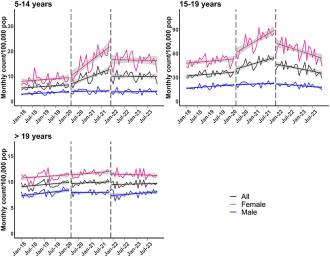News release
From:
Thirty-seven percent increase in deliberate self-poisonings among girls during COVID-19 lockdowns
A new study reveals a 37 percent increase in deliberate self-poisonings among female children and adolescents over the last four years. The increase is strongly correlated with COVID-19 pandemic restrictions.
Published in the Australian and New Zealand Journal of Psychiatry, the study found rates of deliberate self-poisoning were 84 percent higher among those aged 5-14 years, and 36 percent higher among those aged 15-19 years, than before the pandemic. There were only minor changes in males and older Australians.
Within the 5–14-year-old cohort, self-poisonings rose particularly among adolescent females aged 11 to 14. The researchers say the rise in self-poisoning by adolescent females appeared to be driven by lockdowns rather than COVID-19 infections. This marked increase occurred between March 2020 and December 2021 coinciding with widespread lockdowns during that period. Following the relaxing of restrictions in early 2022, there was a sudden drop and then slow decline, however, rates remain well above pre-pandemic rates.
Self-poisoning is the most common form of hospitalised self-harm among children and adolescents and had increased in the decade prior to the pandemic.
“These findings suggest the pandemic lockdowns severely and disproportionately impacted the mental health of female adolescents,” said senior author Professor Nicholas Buckley from the University of Sydney’s School of Pharmacy.
“Factors such as social isolation, family conflict, and perceived educational impact may have had more impact on female adolescents than other groups,” he said.
Over the six years, there were 201,755 self-poisonings documented in Australia, with females comprising 64 percent of all poisonings.
22 percent were adolescents aged 15-19 and almost 10 percent were children aged 5–14. There was a steep increase in the rate of deliberate self-poisoning among female children and adolescents (37 percent) compared with males (11 percent).
There were also substantial jurisdictional variations, with larger increases in Victoria, Tasmania and the Australian Capital Territory.
“This may have been a result of more severe lockdowns in Victoria, and the possible impact of interstate travel restrictions in Tasmania and the Australian Capital Territory. However, all states had significant increases,” said Professor Buckley.
“Ongoing real-time surveillance of self-harm and mental health service use should be part of our national preparation for the next pandemic or health crisis,” he said.
While the study did not measure the health outcomes of deliberate-self poisonings among the studied groups, the researchers note that while most deliberate self-poisonings do not result in fatality, a previous study found that self-harming behaviour in adolescence increases the future risk of suicide.
"Nevertheless, these findings are very concerning — an increase in non-fatal self-harm may lead to increases in future suicide rates for this age group,” said Professor Buckley.
HOW THE RESEARCH WORKED
The researchers used 2018—2023 data on phone calls to all Australian poisons information centres, made by health care professionals and members of the public. The researchers say it is the most comprehensive and up-to-date Australian data on intentional self-harming behaviour.
-ENDS-
Research:Noghrehchi, Firouzeh, Self-poisoning in young Australians: The
impact of COVID-19 and recent trends following easing of restrictions.DOI:doi.org/10.1177/00048674241291321
Declaration: The authors declare no competing interests. The work was supported by NHMRC Investigator Grants (2007726 and 1196516).
Multimedia




 Australia; NSW; VIC; QLD; WA
Australia; NSW; VIC; QLD; WA


